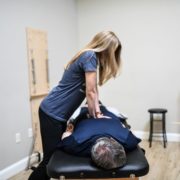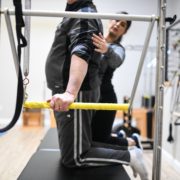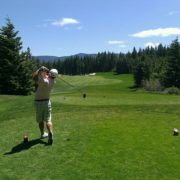6 Tips to Protect your Back when Raking Leaves
Leaves are everywhere right now in New England, which means for many, the tedious task of raking them is right around the corner. I love Fall – but I don’t love raking leaves. And raking leaves is even worse when you’re suffering from back pain. The good news is there are many things you can do to protect your back when raking leaves.
Here are 6 of my most popular tips to protect your back when raking leaves:
1. Warm up before you start.
Just as athletes warm up before a game, so should you before raking. Beginning any physical activity without preparing your body can lead to unwanted strains and injuries. For raking, focus on warm up activities that target your back, shoulders, and legs. Something like a quick walk around the block before you start is an excellent way to warm up. It gets blood flowing to your legs and arms, and the gentle rotational aspect of walking is great for your spine and torso. You could also include some basic stretches into your warmup such as torso twists, shoulder shrugs, and arm circles. This gets some lubrication into your joints and spine to help protect your back once you start raking.
2. Choose the Right Rake.
With any repetitive activity such as raking – good ergonomics is essential. Ergonomics refers to how safe and efficient you are in your working environment. Bad ergonomics will typically cost you unnecessary energy and labor – and can often result in an injury. When it comes to raking, choose a rake with a handle that is long enough so that you can maintain upright posture while using it, and go for one that is light in weight yet still durable. A good, ergonomic rake might require a bit more investment than you were intending, but it will be worth it in the long run because ultimately, a back injury will cost you much more. And knowing how to protect your back from injury is priceless.
3. Bend with your legs and hips
When performing repetitive activities or lifting something heavy, one of the most vulnerable postures for your back to be in is the combined position of flexed (bent forward) and rotated. To protect your back and avoid injury, you want to use your legs and hips to bend and lift. If you’ve got the right rake, it will be easy to maintain an upright posture while raking. And then when it’s time to scoop up the leaves and deposit them, you’ll want to squat using your hips and knees, and pivot with your trunk and pelvis. Avoid lifting with a curved back and twisting from your waist or spine. Maintaining these habits on a regular basis (not just when raking) will help you protect your back from strain or injury that could otherwise be very easily avoided.
4. Take regular breaks
Continuous and repetitive raking can tire out your muscles and make them more susceptible to injury. Plus, when you get into the monotony of raking, the mindlessness of the activity makes it easy to not pay attention to things like maintaining good posture and using good body mechanics. An easy way to combat this is by taking regular breaks. I recommend at least once every 30 min. Set an alarm on your phone or watch to remind you – and when it goes off – stop what you’re doing, put the rake down, and give yourself a quick upright back stretch. This very simple and easy strategy will go a long way in protecting your back when raking leaves.
5. Engage your Core
You don’t need six-pack abs to protect your back while raking leaves, but simply being mindful of your core can be super helpful and certainly won’t hurt you. Most back injuries occur when you least expect it – and when you aren’t paying attention. When you’re raking leaves, or any other mindless, repetitive activity for that matter, make an effort to think about gently drawing in your lower abdominals while you perform the activity. It’s a subtle move, and you should be able to easily breathe and talk while doing it. If you struggle to breathe and talk normally – you’re overdoing it. This simple act of engaging your core will help keep your spine more supported and stable while raking and it will help protect your back.
6. Keep Moving Afterwards
What you do after raking is equally as important as what you do during to help protect your back from pain and injury. One of the biggest mistakes people make after a repetitive or strenuous activity (like raking) is to slump on the couch or recliner and “rest”. This is one of the worst things you can do to your spine because it’s more pliable and vulnerable right after strenuous activity. And when you put your spine in a relaxed, flexed position while it’s vulnerable – you’re just asking for an injury. You won’t notice it while you’re resting – but you might feel a tweak or strain when you go to stand up – or even up to several hours later. Do yourself a favor and perform some gentle stretching after raking, or go for another walk to help relax your back. And be mindful of your resting postures for a few hours after raking. This is an easy way to protect your back during raking season.
Hopefully these tips give you a few things to think about before you go raking all those leaves in your yard – but most importantly – help you protect your back and avoid unwanted back pain this fall season.
Dr. Carrie Jose, Physical Therapist and Pilates expert, owns CJ Physical Therapy & Pilates in Portsmouth and writes for Seacoast Media Group. To request a free copy of her guide to back pain CLICK HERE or to get in touch, email her at [email protected].











